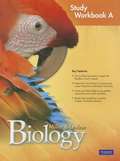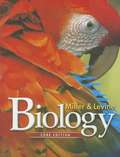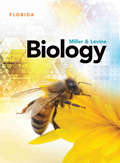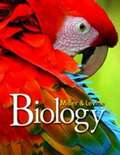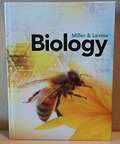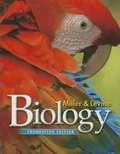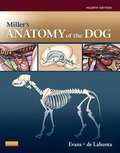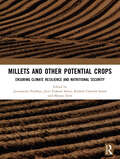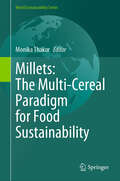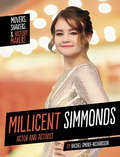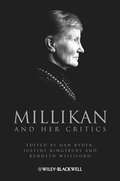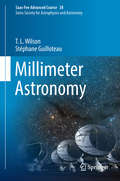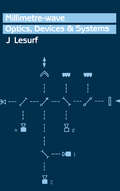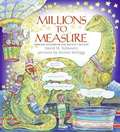- Table View
- List View
Miller & Levine Biology (Alabama Edition)
by Kenneth R. Miller Joseph Levine"The respected author team of Ken Miller and Joe Levine are back with a new edition of biology books to inspire students to interact with trusted and up-to-date biology content. The authors' unique storytelling style engages students in biology, with a greater focus on written and visual analogies.
Miller & Levine Biology (Oregon Edition)
by Kenneth R. Miller Joseph S. LevineMiller & Levine Biology offers educators an unprecedented opportunity to address the needs of today's classroom in a fresh new way with: - Integrated inquiry throughout each lesson - Engaging visuals that enhance instruction - The next-generation of digital instruction built for 21st Century learners - Differentiated instruction and accessible content that helps to address all types and levels of learners. The text encourages inquiry-based discovery by asking students to think like scientists through a variety of organizing principles and features.
Miller & Levine Biology 2010 Study Workbook A
by PearsonStudy Workbook A for Miller & Levine Biology is designed to help you acquire skills that will allow you to study biology more effectively. Your active participation in class and use of this workbook can go a long way toward helping you achieve success in biology. This study workbook can be used to preview a chapter, learn key vocabulary terms, master difficult concepts, review for chapter and unit tests, practice 21st Century Skills.
Miller & Levine Biology, Core Edition
by Kenneth R. Miller Joseph S. LevineThe Core Edition of Miller & Levine Biology is the perfect option for a classroom looking for a concise textbook that is light on the book bag. Accompanied by robust digital support on Biology.com, the Core Edition covers the following standards-based units: the Nature of Life, Ecology, Cells, Genetics, Evolution
Miller & Levine Biology, Foundation Edition
by Kenneth R. Miller Joseph S. LevineNIMAC-sourced textbook
Miller & Levine Biology, Foundation Edition
by Kenneth R. Miller Joseph S. LevineNIMAC-sourced textbook
Miller & Levine Biology, Foundations, Reading and Study Guide Workbook
by Prentice-Hall StaffNIMAC-sourced textbook
Miller & Levine Experience Biology
by Kenneth R. Miller Joseph S. Levine Carol BakerNIMAC-sourced textbook
Miller & Levine Experience Biology: The Living Earth
by Kenneth R. Miller Joseph S. LevineNIMAC-sourced textbook
Miller and Levine Biology, Foundation Edition
by Kenneth R. Miller Joseph S. LevineA great option for low-level and inclusion classrooms, with digital support on Biology. com. Authors Ken Miller and Joe Levine deliver the same trusted, relevant content in more accessible ways! Written at a lower grade level with a reduced page count, the text offers additional embedded reading support to make biology come alive for struggling learners. Foundations for Learning reading strategies provide the tools to make content accessible for all your students.
Miller's Anatomy of the Dog (Fourth Edition)
by Howard E. Evans Alexander De LahuntaNow in full-color, Miller's Anatomy of the Dog, 4th Edition features unparalleled coverage of canine morphology, with detailed descriptions and vivid illustrations that make intricate details easier to see and understand. Updated content reflects the latest knowledge on development, structure, and function, making this a valuable reference for anatomists, veterinary students, technicians, clinicians, experimentalists, and breeders. It is also useful in specialty fields such as mammalogy, biomechanics, and archaeology. Chapters are logically organized by body system for quick reference. Contributors are expert anatomists who provide the most current information and share their knowledge of particular structures. An introductory chapter includes breed categories from both the American and British Registry Clubs to give you a clearer understanding of dog breeds and how they are determined. NEW! Elaborate, full-color illustrations created by an expert medical illustrator bring canine structures to life and enhance your understanding of their function. New and updated content reflects the most up-to-date nomenclature from the Nomina Anatomica Veterinaria (NAV) - the standard reference for anatomical (zootomical) terminology. Text and bibliographic references from the most current literature allow you to access all primary sources of information for further study and interpretation.
Millet Rhizosphere (Rhizosphere Biology)
by Anil Kumar Sharma Ramesh Namdeo Pudake Maya Kumari Deepak Rameshwar SapkalThis edited volume is the first book that explicitly explains the link between the extraordinarily small-scale microbial processes and the growth and yield attributes of millet crops. This book includes chapters emphasizing on the effects of rhizosphere biology on long-term millet crop management. Millets are a collection of small-grained cereal grasses that are grown for human carbohydrate needs. They are among the oldest crops, mainly divided into two groups: major and small millets based on seed size. Major millets are composed of sorghum (Sorghum bicolor) and pearl millet (Pennisetum glaucum); while small millets are composed of six species that includes finger millet (Eleusine coracana (L.)), little millet (Panicum sumatrense), kodo millet (Paspalum scrobiculatum (L.)), foxtail millet (Setaria italica (L.)), barnyard millet (Echinochloa frumentacea (L.)), and proso millet (Panicum miliaceum (L.). These crops are earlier considered as orphan crops, but recently due to their nutritional values it is gaining the importance. Various reports are published based on role of rhizosphere on growth and health of these crops. The rhizosphere being a dynamic interface among the plant roots and soil microbes provides a number of advantages to the millets too. The soil properties in rhizospheric region are also different as compared to the bulk soil. This book discovers the functional attributes of rhizosphere in promoting the healthy growth of millet crop and achieving higher yield during the changing climatic condition. This book is of interest to university teachers, scientists working in the millets, and policymakers in agricultural departments. Also, the book serves as additional reading material for undergraduate and graduate students of agriculture, biotechnology, microbiology, genetics, and soil science.
Millets and Other Potential Crops: Ensuring Climate Resilience and Nutritional Security
by Jyoti Prakash Sahoo Jyostnarani Pradhan Manasi Dash Kailash Chandra SamalDeeply rooted in indigenous peoples’ culture and traditions, millets (also called ‘nutricereals’ are ancestral crops high in nutritional value. As the global agrifood systems face challenges to feed an ever-growing global population, resilient cereals like millets provide an affordable and nutritious option and help guarantee food security.This book presents the basic principles and practices of millets and other potential crops towards climate resilience and nutritional security. It discuses the role of millets in sustainable agriculture, the medicinal use of foxtail millet, exotic fruits in India, and climate-resilient fruit and vegetable crops.The goal of this work is to promote the sustainable cultivation of millets, also under adverse and changing climatic conditions and improving their quality, highlighting their potential to provide new sustainable market opportunities for producers and consumers.Print edition not for sale in South Asia (India, Sri Lanka, Nepal, Bangladesh, Pakistan or Bhutan)
Millets: The Multi-Cereal Paradigm for Food Sustainability (World Sustainability Series)
by Monika ThakurThis book delves into the specific subject area of life sciences, focusing on the remarkable world of millets and their multifaceted contributions. This book serves as a comprehensive guide to the diverse aspects of millets, addressing their biology, significance, functional potential, and applications. The content in this book is divided into two distinct sections, Section I contains the detailed introduction to the Millets, their biology, classification, applications, and various types (major, minor, and pseudo millets) and Section II contains their safety, extraction, industrial applications, and SDG goals. This book is not only an asset for professionals and experts but also a readable guide for Academicians and advanced students looking to engage with this ever-expanding subject area. The book is a boon for entrepreneurs in the area millets, as they will get the complete comprehensive information about all the different types of millets with their biology, functional potential and processing.
Millicent Simmonds: Actor and Activist (Movers, Shakers, and History Makers)
by Rachel Smoka-RichardsonDeaf actor Millicent Simmonds captivated audiences with her performances in Wonderstruck and A Quiet Place. She has appeared in music videos, TV episodes, and at awards shows that have brought awareness to how deaf people experience the world. Learn more about this talented young actor and how she intends to give deaf people the space to tell their own stories.
Millikan and Her Critics (Philosophers and their Critics #15)
by Kenneth Williford Dan Ryder Justine Ki NgsburyMillikan and Her Critics offers a unique critical discussion of Ruth Millikan's highly regarded, influential, and systematic contributions to philosophy of mind and language, philosophy of biology, epistemology, and metaphysics. These newly written contributions present discussion from some of the most important philosophers in the field today and include replies from Millikan herself. Comprises 13 new essays that critically examine the highly regarded and influential work of Ruth Millikan Covers a wide range of Millikan's most important work, from philosophy of mind and language to philosophy of biology Features contributions by some of the most important and influential philosophers working today Includes original replies to critics by Millikan
Millimeter Astronomy: Saas-Fee Advanced Course 38. Swiss Society for Astrophysics and Astronomy (Saas-Fee Advanced Course #38)
by T. L. Wilson Stéphane Guilloteau Miroslava Dessauges-Zavadsky Daniel PfennigerThe millimeter and sub-millimeter wavebands are unique in astronomy in containing several thousands of spectral lines of molecules as well as the thermal continuum spectrum of cold dust. They are the only bands in the electromagnetic spectrum in which we can detect the molecular gas reservoir for star formation and cold dust far away in high-redshift galaxies, and nearby in low-temperature cocoons of protostars and protoplanets.This book is based on and extensively updated from the lectures given during the Saas-Fee Advanced Course 38 on millimeter astronomy. It presents both the observing techniques and the scientific perspectives of observations at millimeter wavelengths, here in particular the star and planet formation.The chapters by Thomas L. Wilson and Stéphane Guilloteau have been edited by Miroslava Dessauges-Zavadsky and Daniel Pfenniger. The book is part of the series of Saas-Fee Advanced Courses published since 1971. The targeted audience are graduate PhD and advanced undergraduate students, but the book also serves as reference for post-doctoral researchers or newcomers to the field.
Millimetre-Wave Optics, Devices and Systems
by J.C.G LesurfThe millimetre-wavelength region of the electromagnetic spectrum is increasingly exploited for a wide range of commercial, industrial, and military applications. Conventionally, this region is considered as lying "above" microwaves and "below" the infrared. Hence, in practice, millimetre-wave scientists have tended to pick and mix useful techniques on an empirical basis from both these areas. Millimetre-Wave Optics, Devices and Systems describes the fundamental physics of the quasi-optical techniques, devices, and system design for instruments processing millimetre-wave signals. Relevant ideas from Gaussian beam mode theory and antenna and transmission line theory are brought together to show the underlying unity of optics and electronics. Aimed at advanced undergraduates and postgraduates as well as millimetre-wave, laser optics, antenna, and microwave engineers, this book will also be of interest to manufacturers of millimetre-wave and microwave equipment.

